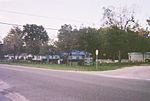Floral City Heritage Hall Museum

Floral City Heritage Hall Museum is a museum in Floral City, Florida, United States. The museum is located in a Fire Station building in downtown Floral City. The fire station closed in January 2000 and the museum opened on December 4, 2009, for Floral City Heritage Days as the Heritage Museum & Country Store. It includes two galleries, a library, media center, and store. Offices, storage and a kitchen were under construction in 2014. In 2014, its website stated the museum is open Friday and Saturday from 10:00 a.m. to 2:00 p.m. as well as for special events. The museum is located next to the Community Building and Library on Orange Avenue, one block east of U.S. Highway 41. It is operated by the Floral City Heritage Council.
Excerpt from the Wikipedia article Floral City Heritage Hall Museum (License: CC BY-SA 3.0, Authors, Images).Floral City Heritage Hall Museum
South Old Floral City Road,
Geographical coordinates (GPS) Address Nearby Places Show on map
Geographical coordinates (GPS)
| Latitude | Longitude |
|---|---|
| N 28.74984 ° | E -82.29497 ° |
Address
Floral City Fire Department
South Old Floral City Road
34450
Florida, United States
Open on Google Maps









